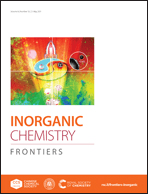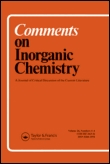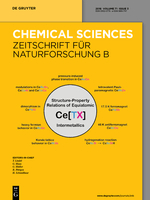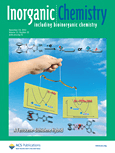
JOURNAL OF COORDINATION CHEMISTRY
Scope & Guideline
Advancing Knowledge in Coordination Chemistry Since 1971
Introduction
Aims and Scopes
- Synthesis and Characterization of Coordination Compounds:
The journal publishes studies on the synthesis of novel coordination compounds, including detailed characterization using techniques like X-ray crystallography, NMR spectroscopy, and mass spectrometry. - Metal-Ligand Interactions:
Research focusing on the interactions between metal ions and various organic and inorganic ligands is a core area, encompassing studies on bonding modes, stability, and reactivity of these complexes. - Biological Applications of Metal Complexes:
Many papers explore the biological implications of metal complexes, including their potential as therapeutic agents, antimicrobial properties, and interactions with biomolecules such as DNA and proteins. - Catalytic Activity of Metal Complexes:
The journal highlights research on the catalytic properties of coordination compounds, particularly in organic transformations, environmental remediation, and photochemical applications. - Nanomaterials and Hybrid Systems:
There is a growing emphasis on the development of nanostructured materials and hybrid systems that integrate coordination chemistry with nanotechnology for applications in sensing, catalysis, and drug delivery.
Trending and Emerging
- Green Chemistry and Sustainable Practices:
There is an increasing focus on environmentally friendly synthesis methods, including green solvents and processes, which aligns with global sustainability goals. - Photocatalysis and Solar Energy Applications:
Research on the photocatalytic properties of metal complexes and their applications in solar energy conversion and environmental remediation is gaining traction, reflecting broader interest in renewable energy solutions. - Advanced Characterization Techniques:
The use of advanced characterization methods, including computational chemistry, DFT calculations, and high-resolution spectroscopy, is becoming more prevalent, allowing for a deeper understanding of metal-ligand interactions. - Functional Nanomaterials:
Emerging studies are focusing on the development of functional nanomaterials based on coordination compounds, particularly for applications in drug delivery, sensing, and environmental cleanup. - Biological and Medicinal Applications:
There is a growing trend towards exploring the therapeutic applications of metal complexes, particularly in the context of cancer treatment and antimicrobial activity, emphasizing the importance of coordination chemistry in medicine.
Declining or Waning
- Traditional Coordination Chemistry:
There has been a noticeable decrease in studies focusing solely on traditional coordination compounds without novel applications or interdisciplinary approaches, as researchers increasingly seek to integrate coordination chemistry with other fields. - Inorganic Materials with Limited Functionalization:
Research on simple inorganic coordination materials that lack significant functionalization or application potential is declining, as the focus shifts towards more complex and functionalized systems. - Metal Complexes with Limited Biological Relevance:
Papers that present metal complexes without significant biological evaluation or therapeutic implications are becoming less frequent, reflecting a growing emphasis on the biomedical potential of coordination compounds.
Similar Journals

Chemistry-Switzerland
Unlocking the Future of Chemistry, One Article at a TimeChemistry-Switzerland is an esteemed, fully Open Access journal published by MDPI, dedicated to advancing research in a broad spectrum of chemistry disciplines. Launched in 2019, the journal has established itself within the academic community, particularly as it spans critical areas such as inorganic and organic chemistry, as well as electrochemistry. Recognized for its contributions, it has achieved notable rankings, including Q2 status in Chemistry (miscellaneous) and Inorganic Chemistry, and Q3 standing in Electrochemistry and Organic Chemistry for 2023. With a commitment to disseminating high-quality research, Chemistry-Switzerland serves as an invaluable resource for researchers, professionals, and students aiming to share their discoveries with a global audience. Located in Basel, Switzerland, this journal facilitates seamless access to cutting-edge research, fostering innovation and collaboration within the vibrant field of chemistry. With this dynamic platform, the journal aims to continue its trajectory of growth and impact, inspiring the next generation of chemists.

REVIEWS IN INORGANIC CHEMISTRY
Charting the Course of Inorganic ChemistryREVIEWS IN INORGANIC CHEMISTRY, published by Walter de Gruyter GmbH, is a distinguished academic journal that serves as a vital resource for researchers, professionals, and students within the field of inorganic chemistry. With its ISSN 0193-4929 and E-ISSN 2191-0227, this journal has made a significant impact on the discipline, holding a commendable Q2 ranking in the 2023 category of Inorganic Chemistry, placing it in the 81st percentile among its peers according to Scopus rankings. Continuously published since its inception, with converged years spanning from 1985 to 1990 and 1992 to 2024, it features comprehensive reviews encompassing the latest advancements, methodologies, and theoretical frameworks in the subject. Researchers will find IDEAL insights and valuable discussions that keep them abreast of trends and challenges in the domain, essential for driving innovation and collaboration. The journal’s commitment to quality and rigorous peer review highlights its importance in advancing inorganic chemistry research, making it an indispensable tool for academic excellence.

Inorganic Chemistry Frontiers
Pioneering Research in Inorganic ChemistryInorganic Chemistry Frontiers, published by the esteemed Royal Society of Chemistry, stands at the forefront of advancements in the field of inorganic chemistry, boasting a prestigious Q1 ranking in its category as of 2023 and an impressive Scopus Rank of #3 out of 79, placing it in the 96th percentile. Since its inception in 2014, this journal has provided a robust platform for high-quality research that spans the diverse and rapidly evolving areas of inorganic chemistry. As an open-access journal, it ensures that the findings presented are readily accessible to researchers, educators, and practitioners globally, fostering an inclusive environment for the dissemination of knowledge. With its rigorous peer-review process, Inorganic Chemistry Frontiers aims to facilitate interdisciplinary dialogue and innovation, making it an essential resource for anyone dedicated to exploring the myriad applications and theoretical advancements within inorganic chemistry.

JOURNAL OF BIOLOGICAL INORGANIC CHEMISTRY
Exploring the Intersection of Chemistry and Life.JOURNAL OF BIOLOGICAL INORGANIC CHEMISTRY, published by Springer, serves as a pivotal platform for the dissemination of research that intersects the fields of biochemistry and inorganic chemistry. With a commitment to advancing our understanding of the intricate roles that inorganic elements and compounds play in biological systems, this journal addresses a diverse array of topics from metal ion interactions in biological processes to the design of biomimetic systems. Hailing from Germany and reaching a global audience, it has maintained a distinguished status in its field, achieving a Q2 ranking in Inorganic Chemistry and a Q3 ranking in Biochemistry as of 2023, reflecting its impactful contributions to the scientific community. Although currently not open access, the journal provides vital insights that are essential for researchers, professionals, and students alike, promoting knowledge and collaboration in a rapidly evolving scientific landscape. With an expansive range of articles published since 1996, the JOURNAL OF BIOLOGICAL INORGANIC CHEMISTRY continues to be an indispensable resource for anyone working at the intersection of chemistry and biology, especially in understanding the biochemical implications of inorganic substances.

INORGANICA CHIMICA ACTA
Driving Excellence in Inorganic ResearchINORGANICA CHIMICA ACTA is a distinguished journal published by Elsevier Science SA, focusing on the dynamic fields of inorganic chemistry, materials chemistry, and physical and theoretical chemistry. Established in 1967, the journal continues to contribute to the scientific community with a commitment to high-quality research and innovation, boasting a 2023 Scopus ranking that places it at the forefront of its category, including a notable rank of #25 out of 79 in Inorganic Chemistry. Researchers can access a wealth of knowledge through its assemblage of influential articles; though it does not offer open access, the journal remains a key resource in the Netherlands and beyond. With an impact factor reflective of its rigorous editorial standards and engagement, INORGANICA CHIMICA ACTA is essential for scholars and professionals seeking to deepen their understanding and advance their research in these interconnected scientific domains.

COMMENTS ON INORGANIC CHEMISTRY
Advancing the Frontiers of Inorganic ChemistryCOMMENTS ON INORGANIC CHEMISTRY is a prestigious academic journal published by Taylor & Francis Ltd, specializing in the dynamic field of inorganic chemistry. With an impressive impact factor placing it in the Q1 category, this journal ranks #6 out of 79 in its field, reflecting its high influence and contribution to the discipline, with a remarkable percentile ranking of 93rd. Since its inception in 1981 and spanning publications until 2024, this journal serves as a crucial platform for researchers, professionals, and students to disseminate groundbreaking findings, review articles, and discussions on contemporary topics in inorganic chemistry. Although it is not an Open Access journal, the rigorous peer-review process ensures the publication of high-quality research. By bridging theoretical and practical aspects of inorganic chemistry, COMMENTS ON INORGANIC CHEMISTRY remains an essential resource for advancing knowledge and fostering innovation within the scientific community.

Inorganic and Nano-Metal Chemistry
Catalyzing Discoveries in Inorganic and Nano-Metal Science.Inorganic and Nano-Metal Chemistry is a premier journal published by Taylor & Francis Inc, focusing on innovative research and advancements in the fields of inorganic chemistry and nano-metal applications. With an increasing impact in the academic community, this journal has established itself within the Q3 category of both Inorganic Chemistry and Physical and Theoretical Chemistry as of 2023, reflecting its global recognition and influence. The journal is accessible as an Open Access publication, ensuring that research findings are freely available to a broad audience, promoting transparency and collaboration in scientific exploration. Based in the United Kingdom, Inorganic and Nano-Metal Chemistry aims to disseminate high-quality peer-reviewed articles that not only highlight fundamental studies but also push the boundaries of technological applications in areas such as catalysis, materials science, and nanotechnology. Researchers, professionals, and students will find this journal an invaluable resource for the latest developments and interdisciplinary insights in the ever-evolving landscape of inorganic and nano-metal chemistry.

ZEITSCHRIFT FUR NATURFORSCHUNG SECTION B-A JOURNAL OF CHEMICAL SCIENCES
Advancing Chemical Knowledge Through Rigorous ResearchZEITSCHRIFT FUR NATURFORSCHUNG SECTION B-A JOURNAL OF CHEMICAL SCIENCES is a distinguished scholarly journal published by Walter de Gruyter GmbH, based in Berlin, Germany. Since its inception in 1947, this journal has served as a vital platform for the dissemination of innovative research and findings in the field of chemical sciences. With an ISSN of 0932-0776 and E-ISSN of 1865-7117, it is indexed in prominent databases, reinforcing its credibility and accessibility for researchers and professionals alike. Currently categorized in the third quartile (Q3) in the field of miscellaneous chemistry according to 2023 assessments, it holds a significant position in the landscape of chemical research, ranking 270th out of 408 in general chemistry with a percentile standing of 33%. Although not an Open Access publication, its rigorous peer-review process ensures the publication of high-quality articles that contribute to advancing knowledge and innovation in chemistry. The journal’s commitment to scientific excellence makes it an essential resource for students and professionals seeking to stay updated with the latest developments in chemical sciences.

MAIN GROUP METAL CHEMISTRY
Innovating Materials Science through Metal ChemistryMAIN GROUP METAL CHEMISTRY, published by De Gruyter Poland Sp. z o. o., is an esteemed open access journal that has made a significant impact in the fields of Chemistry, Condensed Matter Physics, and Materials Science since its inception in 1988. With its ongoing publication aimed at advancing scholarly discourse until 2024, this journal is indexed in leading databases and has earned a diverse readership due to its rigorous peer-review process and relevant contribution to the understanding of metal chemistry. In the 2023 category quartiles, it has been recognized as Q2 in Metals and Alloys and holds Q3 rankings in Chemistry (miscellaneous), Condensed Matter Physics, and Materials Chemistry, showcasing its interdisciplinary appeal and recognition in the scientific community. The journal's innovative open access model, implemented in 2019, enhances visibility and accessibility for researchers worldwide, fostering collaboration and discovery among professionals, students, and academics alike. By presenting high-quality research and critical reviews, MAIN GROUP METAL CHEMISTRY serves as a vital resource for those seeking to deepen their understanding of metal interactions and their applications in advanced materials.

INORGANIC CHEMISTRY
Exploring Innovative Pathways in Inorganic ResearchInorganic Chemistry, published by the American Chemical Society, stands at the forefront of the field of inorganic and physical chemistry, boasting an impressive impact in the academic community with a 2023 classification in the Q1 quartile across multiple categories including Inorganic Chemistry and Miscellaneous Chemistry. Since its inception in 1962, this esteemed journal has been a crucial platform for disseminating groundbreaking research, innovative methodologies, and comprehensive reviews integral to understanding the complex behaviors of inorganic materials. With a ranking of #12 out of 79 in Inorganic Chemistry and #37 out of 189 in Physical and Theoretical Chemistry according to Scopus metrics, Inorganic Chemistry has established itself as a premier destination for researchers, professionals, and students alike, eager to stay abreast of pivotal developments and trends in the discipline. Despite being a subscription-based journal, its esteemed reputation and critical contributions make it essential for anyone engaged in the exploration of inorganic chemical phenomena. As it prepares to converge into a new era by 2024, the journal continues to embody excellence and innovation, fostering a dynamic exchange of ideas essential for advancing this vibrant area of science.